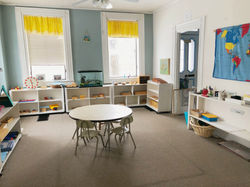LISBON MONTESSORI PRESCHOOL
The Montessori Classroom
 |  |  |
|---|---|---|
 |  |  |
 |
The Montessori classroom is designed as a child-centered environment and is “prepared” for the children. Everything in the room has a specific place on the shelf with the materials easily within the child’s reach at their eye level. Items found on shelves in the classroom are “materials” rather than “toys.” The children “work with the materials” rather than “play with the toys.” The tables and chairs are small enough for the children to sit comfortably while the pictures and decorations are placed at the children’s eye level. Children are orderly by nature and having the room set this way allows them to grow in a very positive way.
The teacher's play a less obtrusive role in the classroom. The children are not exclusively taught by the teachers, but rather inspired and stimulated by their presence and presentations to encourage the child's own innate need for self-development. Boundaries and limits are clearly and firmly, but gently and cheerfully laid out.
The classroom provides a sense of community that develops and aids in building self-esteem and self-worth within the child. A three year age span of children within the classroom provides an environment where older children model for and assist younger children, and younger children observe, emulate, and turn to older ones. The environment provides a natural sense of discipline. The expectations of the community are developed through lessons in “grace and courtesy” which elevate the relationships and behaviors of the children. The Montessori classroom allows children to return to their “inner peace” that is a natural part of their personalities. They are “sponges” and delight in learning new tasks. Their interests lie in the process of the work itself rather than in the end product.
Self-correcting materials encompass the environment. The materials are designed so children learn through their own errors to make the correct decision versus having someone point it out to them. There is an emphasis on concrete learning and progresses to abstract thinking. Children need to experience concepts in concrete “hands on” ways so that they make their own leaps to abstraction. Children gain the most benefit from the developmental environment through independent activity.